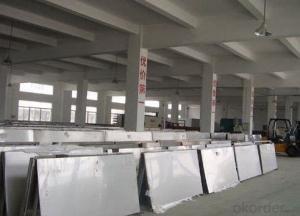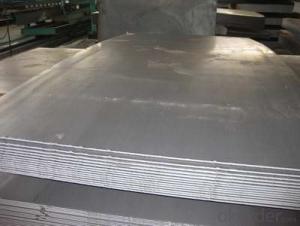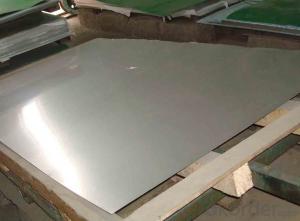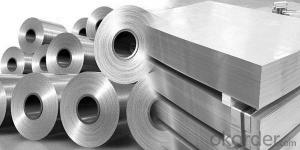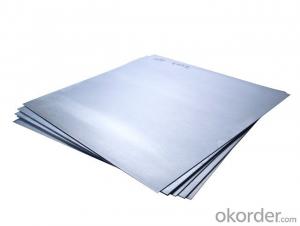Stainless Steel Plate 202 with No.4 Surface Treatment
- Loading Port:
- Shanghai
- Payment Terms:
- TT OR LC
- Min Order Qty:
- 500 m.t.
- Supply Capability:
- 5000000 m.t./month
OKorder Service Pledge
OKorder Financial Service
You Might Also Like
Hot sale stainless steel sheet 201/202/304/304l/316/316l/430
Description of Stainless Steel Sheet:
Description | steel sheet,hot rolled steel sheet,cold rolled steel sheet, steel sheet,sheet,steel plate |
Standard | ASME, ASTM, EN ,BS,GB,DIN, JIS etc |
Application | Steel sheet applies to construction field, ships building industry, petroleum & chemical industries, war and electricity industries, food processing and medical industry, boiler heat exchanger, machinery and hardware fields. |
Packaging | Standard export sea-worthy packing |
Delivery time | 10-30 days |
Quality | No.1 |
Productivity | 500 tons/Day |
Note | Our company has cooperative relation between the domestic agents. Stainless steel sheet can be made accordingto the customers requirements. Fasten delivery. Quality assured. |
Contacts | If you have any question,please feel free contact me. |
Stainless steel sheet surface finish characteristics
Surface finish | Characteristics and application |
2B | The surface brightness and flatness of no2B is better than no2D. then through a special surface treatment to improve its mechanical properties,No2B could nearly satisfy comprehensive uses. |
No.1 | Polished with abrasive belt of grit#100-#200, have better brightness with discontinuous coarse stria, used as inner and external ornaments for building, electrical appliances and kitchen utensils etc. |
No.4 | Polished with abrasive belt of grit #150-#180,have better brightness with discontinuous coarse stria, but thinner than No3, are used as bathtub buildings inner and external ornaments electrical appliances kitchen utensils and food processing equipment etc. |
HL | Polished with abrasive belt of grit #150-#320 on the NO.4 finish and has continuous streaks, mainly used as buildings ornaments elevators, door of building, frontal plate etc. |
BA | Cold rolled, bright annealed and skin-passed, the product have excellent brightness and good reflexivity like mirror, kitchen apparatus, ornament etc. |
8K | The product have excellent brightness and prefer reflexivity can to be the mirror. |
Main Features of stainless steel sheet :
•Escalator, Elevator, Doors
•Furniture
•Production tools, Kitchen appliances, freezers, cold rooms
•Auto Parts
•Machinery and Packaging
•Equipment and Medical devices
•Transport system
Product Details:
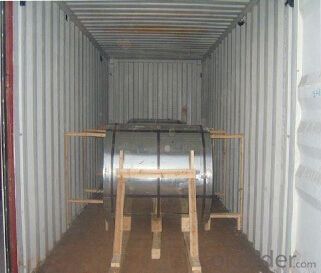
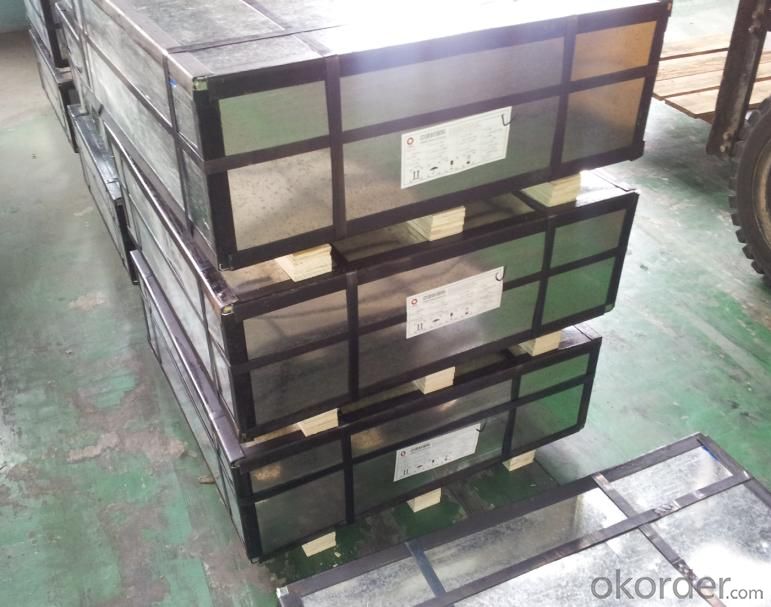
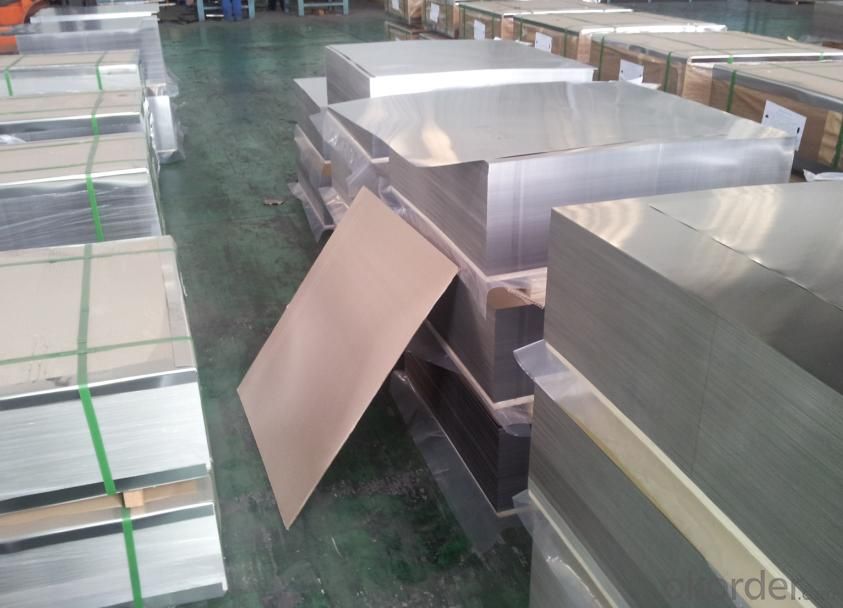
Sandard Seaworth Packing(wooden packing with water proof paper)
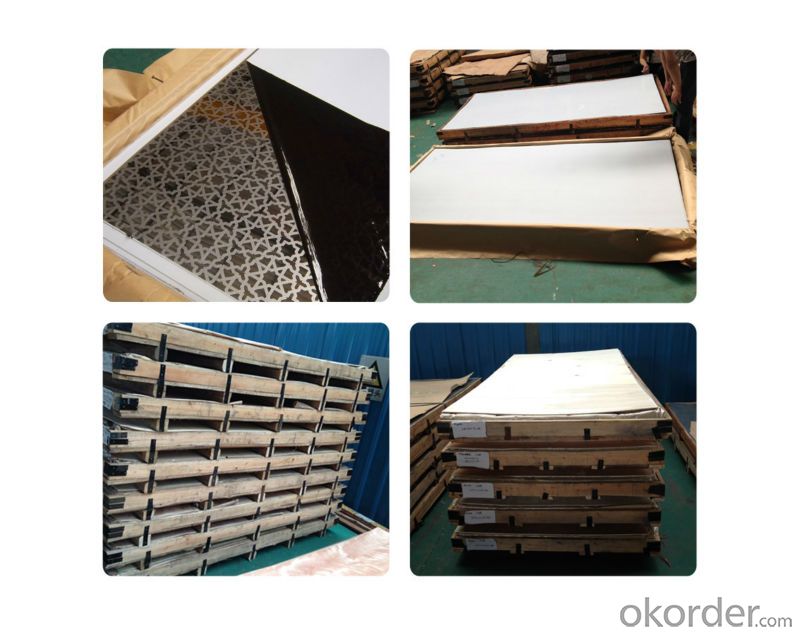
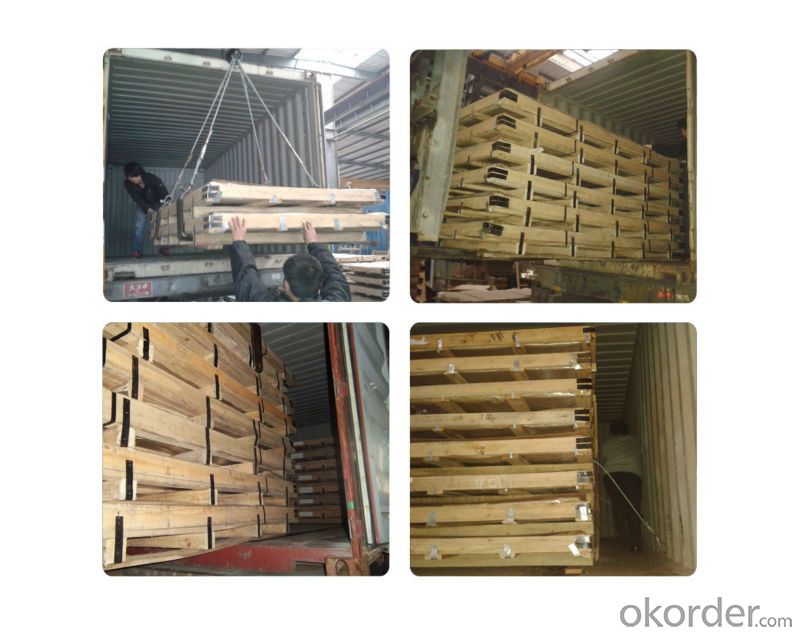
FAQ:
1. What's the quality?
very fine
2. How long get reply?
within 24 hours
If you have any question about stainless steel sheets,donot forget to sending the email to Us! You will get the competitive Price and have a very good experience about the Buying Process! CNBM International Corporation is always your trustful friend!
- Q:Can stainless steel sheets be used in industrial applications?
- Stainless steel sheets possess a myriad of industrial uses without a doubt. Their reputation for outstanding corrosion resistance, durability, and strength renders them perfect for a plethora of industrial settings. The automotive, aerospace, construction, manufacturing, food and beverage, chemical processing, and numerous other sectors regularly employ this material. The utilization of stainless steel sheets primarily stems from their capability to withstand extreme conditions, harsh chemicals, and high temperatures. Their malleability allows for the creation of diverse shapes and sizes, rendering them adaptable for a wide array of applications. Commonly, stainless steel sheets find their purpose in manufacturing equipment, machinery, storage tanks, pipelines, architectural structures, and as a protective layer for corrosion-resistant surfaces. Additionally, stainless steel sheets offer sanitary qualities, which make them particularly suitable for the food and beverage industry. Their effortless cleaning, maintenance, and sterilization ensure compliance with rigorous industry standards. To summarize, stainless steel sheets are versatile and dependable materials that can be effectively utilized in various industrial applications due to their extraordinary corrosion resistance, durability, strength, and sanitary properties.
- Q:What does stainless steel plate mean?
- The corrosion resistance of stainless steel mainly depends on its alloy composition (chromium, nickel, titanium, silicon, aluminum, manganese, etc.) and the internal structure of the alloy, and the main role is chromium. Chromium has high chemical stability, can form a passive film on the steel surface, so that the metal is isolated from the outside, protect the steel plate from oxidation and increase the corrosion resistance of the steel plate. When the passive film is destroyed, the corrosion resistance will decrease.
- Q:What are the different sizes available for stainless steel sheets?
- Stainless steel sheets come in a wide variety of sizes to meet different requirements and applications. The most commonly used sizes for stainless steel sheets are typically 4 feet by 8 feet (1219mm x 2438mm) and 4 feet by 10 feet (1219mm x 3048mm), which are widely used in construction, architecture, and industrial settings. However, smaller sizes of stainless steel sheets are also available, such as 2 feet by 4 feet (609mm x 1219mm) or even smaller. These smaller sizes are commonly used for DIY projects, hobbyists, and smaller-scale applications. On the contrary, larger sizes of stainless steel sheets are available for specific purposes. These can include sheets that measure up to 5 feet by 10 feet (1524mm x 3048mm) or even larger. These larger sizes are often used in specialized industries like shipbuilding, oil and gas, or manufacturing. It is important to note that the thickness of stainless steel sheets can vary independently of their size, as different applications may require different thicknesses. Common thicknesses range from 0.025 inches (0.64mm) to 0.1875 inches (4.76mm) or even thicker for specialized applications. In summary, the availability of stainless steel sheets in various sizes allows for flexibility and customization according to the specific needs of a project, whether it is a small DIY project or a large-scale industrial application.
- Q:How are stainless steel sheets installed?
- Different methods are used to install stainless steel sheets depending on the specific application and requirements. Here are several common installation methods for stainless steel sheets: 1. Adhesive: A popular and straightforward method involves using a specialized adhesive to bond the stainless steel sheet to the desired surface. The adhesive is applied to the back of the sheet, which is then firmly pressed onto the surface. This method is suitable for flat or slightly curved surfaces and results in a seamless and clean installation. 2. Mechanical fasteners: When additional strength and stability are necessary, stainless steel sheets can be installed using mechanical fasteners like screws, bolts, or rivets. These fasteners are drilled or screwed through the sheet and into the surface to secure it. This method is often used for installations that require resistance to external forces or for attaching stainless steel sheets to structural components. 3. Welding: In some cases, particularly for large or complex installations, welding may be employed to connect stainless steel sheets together or to other metal structures. Welding creates a strong and permanent bond between the sheets, ensuring a secure installation. However, this method requires skilled professionals and specialized equipment to ensure proper welding techniques and prevent damage to the stainless steel. 4. Magnetic attachment: Certain stainless steel sheets are designed with a magnetic backing, allowing them to be easily attached to magnetic surfaces. This method offers quick and convenient installation as the sheets can be easily repositioned or removed if necessary. However, it is important to ensure that the magnetic surface is clean and free from debris that could affect the adhesion. Before installing stainless steel sheets, it is crucial to thoroughly clean the surface and remove any dirt, dust, or grease. This preparation will help ensure a secure and long-lasting installation. Additionally, following the manufacturer's instructions and guidelines specific to the stainless steel sheet being installed is essential for achieving the best results.
- Q:Seeking stainless steel plate 304 material and 304j material what is the difference?
- 304 material and 304J1 contain nickel different, 304J1 contain 6 nickel, 304 contain 8 nickel
- Q:What are the different types of stainless steel sheet finishes?
- There are several different types of stainless steel sheet finishes available, each with its own unique characteristics and appearance. Some of the most common finishes include: 1. No.1 Finish: This is the most basic and widely used finish, also known as "hot rolled annealed and pickled" (HRAP). It has a dull, rough surface with visible grain lines. 2. No.2B Finish: This finish is achieved by cold rolling the stainless steel sheet and then annealing it in a controlled atmosphere. It has a smooth, reflective surface with a slight haze. 3. No.2D Finish: Similar to No.2B, this finish is achieved by cold rolling and annealing. However, it has a slightly rougher surface and is commonly used for applications that do not require a highly reflective finish. 4. No.3 Finish: This finish is achieved by polishing the stainless steel sheet with abrasive belts or brushes. It has a semi-reflective surface with a grainy appearance. 5. No.4 Finish: Also known as "brushed finish," this is achieved by using fine abrasive belts or brushes to create a consistent, linear grain pattern on the surface. It has a matte appearance and is commonly used in architectural and decorative applications. 6. No.6 Finish: This finish is achieved by further polishing the stainless steel with finer abrasives, resulting in a smoother and more reflective surface. 7. No.7 Finish: Similar to No.6, this finish is achieved by using even finer abrasives, resulting in a highly reflective surface with a mirror-like appearance. 8. No.8 Finish: Also known as "mirror finish," this is the highest level of polish achievable on stainless steel. It has a flawless, reflective surface that is often used in decorative and high-end applications. In addition to these standard finishes, there are also specialized finishes available, such as embossed, patterned, or colored finishes, which can further enhance the aesthetic appeal of stainless steel sheets. The choice of finish depends on the specific application and desired appearance, with each finish offering its own unique advantages and characteristics.
- Q:What is the impact strength of stainless steel sheets?
- The impact strength of stainless steel sheets can vary depending on several factors, such as the grade and thickness of the stainless steel, as well as the specific conditions under which the impact occurs. Generally, stainless steel has a good level of impact strength due to its inherent properties, including its high tensile strength and ductility. Stainless steel is known for its ability to withstand impacts and resist deformation, making it a preferred material in various industries where durability is crucial. It exhibits excellent resistance to impact loading, which means it can withstand sudden impact forces without fracturing or breaking. This makes stainless steel sheets suitable for applications that require high impact resistance, such as structural components, automotive parts, and machinery. However, it is important to note that different grades of stainless steel have varying impact strengths. Some grades, such as austenitic stainless steels (e.g., 304 and 316), have excellent impact resistance due to their high nickel and chromium content. On the other hand, ferritic and martensitic stainless steels may have slightly lower impact strengths. In addition to grade, the thickness of the stainless steel sheet also plays a role in determining its impact strength. Thicker sheets generally have higher impact resistance compared to thinner ones, as they can absorb more energy before yielding or fracturing. It is worth mentioning that the impact strength of stainless steel can be further enhanced through various methods, including heat treatment and alloying. These processes can improve the material's toughness and resistance to impact loading. Overall, stainless steel sheets have a good impact strength that is suitable for many applications. However, it is recommended to consult the specific grade and thickness specifications, as well as any industry standards or regulations, to determine the exact impact strength requirements for a particular application.
- Q:430 stainless steel plate maximum temperature tolerance is how many degrees?
- 430 stainless steel plate, maximum heat resistance is 900 degrees celsius.
- Q:What factors affect the cost of stainless steel sheets?
- There are several factors that can affect the cost of stainless steel sheets. These include the type and grade of stainless steel, the thickness and size of the sheets, the quantity being purchased, market demand and availability, production and labor costs, and any additional processing or finishing requirements.
- Q:What are the specifications of stainless steel plates? Are they the same width?
- Generally look at the thickness of 0.3-3.0mm, width of 1000/1219/1500. Thickness of 3 or more, with 1240/1250/1500/1800/2000 width. It can be cut as required.... So the purchase is still more flexible.
1. Manufacturer Overview |
|
|---|---|
| Location | |
| Year Established | |
| Annual Output Value | |
| Main Markets | |
| Company Certifications | |
2. Manufacturer Certificates |
|
|---|---|
| a) Certification Name | |
| Range | |
| Reference | |
| Validity Period | |
3. Manufacturer Capability |
|
|---|---|
| a)Trade Capacity | |
| Nearest Port | |
| Export Percentage | |
| No.of Employees in Trade Department | |
| Language Spoken: | |
| b)Factory Information | |
| Factory Size: | |
| No. of Production Lines | |
| Contract Manufacturing | |
| Product Price Range | |
Send your message to us
Stainless Steel Plate 202 with No.4 Surface Treatment
- Loading Port:
- Shanghai
- Payment Terms:
- TT OR LC
- Min Order Qty:
- 500 m.t.
- Supply Capability:
- 5000000 m.t./month
OKorder Service Pledge
OKorder Financial Service
Similar products
New products
Hot products
Hot Searches
Related keywords
